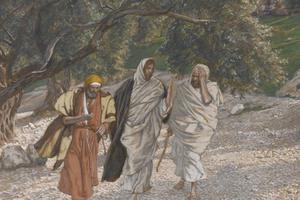The Road to Emmaus: We Shall Know Him in ‘the Breaking of the Bread’
User’s Guide to the Third Sunday of Easter

Sunday, April 23, is the Third Sunday of Easter. Mass readings: Acts 2:14, 22-33; Psalm 16:1-2, 5, 7-8, 9-10, 11; 1 Peter 1:17-21; Luke 24:13-35
In today’s Gospel, we encounter two discouraged and broken men making their way to Emmaus.
It is late in the afternoon, and the sun is sinking low. They are also moving in the wrong direction, west. They have their backs to the Lord, rising in the east. How will the Lord reorient them, turn them in the right direction?
The Lord will do this by celebrating Holy Mass with them. Let’s examine this Mass.
Gathering Rite
The curtain rises on this Mass with two disciples having gathered together on a journey. This is what we do as the preliminary act of every Mass. “And it happened that … Jesus himself drew near and walked with them” (Luke 23:15). When we gather together at Mass, the Lord Jesus is also with us. Scripture says, “For where two or three are gathered in my name, there am I among them” (Matthew 18:20).
Penitential Rite
The two disciples seem troubled, and the Lord inquires of them the source of their distress: “What are you discussing as you walk along?” (Luke 24:17). In effect, the Lord engages them in a kind of gentle penitential rite, speaking to them about their negativity. So, too, for us at Mass. We, too, often enter the presence of God looking downcast and carrying many burdens and sins. Like these disciples, we may be walking in the wrong direction. In effect, the Lord says to us, “What are thinking about as you walk along? Where are you going with your life?”
Liturgy of the Word
“Then, beginning with Moses and all the prophets, he interpreted to them what referred to him in all the Scriptures” (Luke 24:27).
Not only does the Lord refer to Scripture, he interprets it for them. Hence the word is not merely read; there is a homily, an explanation and application of the Scripture to the men’s struggles. So, too, for us at Mass. The Lord bids us to listen to his word as the Scriptures are proclaimed, and the homilist interprets and applies the word to our life, as Christ himself “spoke ... and opened the Scriptures” to the disciples on the road to Emmaus.
Liturgy of the Eucharist
They ask Christ to stay for supper. “And it happened that, while he was with them at table, he took bread, said the blessing, broke it, and gave it to them” (Luke 24:30). Yes, it is the Mass, to be sure. All the basic actions of the Eucharist are there: He took, blessed, broke and gave. They are the same actions that took place at the Last Supper and that we repeat at every Mass. “With that, their eyes were opened, and they recognized him, but he vanished from their sight” (Luke 24:31). That Jesus vanishes from their sight teaches us that he will no longer be seen with the eyes of the flesh, but with the eyes of faith. He is now to be encountered in the sacraments and the liturgy.
Go in Peace
“So they set out at once and returned to Jerusalem where they found gathered together the eleven … recounted what had taken place on the way and how he was made known to them in the breaking of the bread” (Luke 24:33-35).
Note that this liturgy has reoriented them. They are now heading back east, toward the Risen Son. Consider these two men who began this Gospel quite downcast. Their hearts are now on fire, and they now see. The Lord has celebrated Mass in order to get them to this point. So, too, for us: The Lord celebrates Mass in order to set our hearts on fire and open our eyes to glory.
- Keywords:
- road to emmaus
- church teaching on the eucharist
- easter season
- user's guide to sunday
- user’s guide to sunday
















